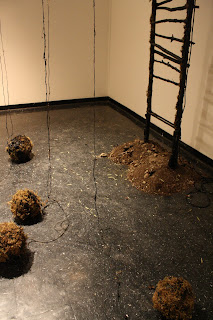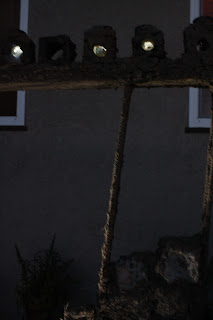The following photographs are a catalogue of recent work from May to the 7/30/2012:

Fig.1
The following images constitute four of five works in a recent advancement exhibition at SDSU in pursuit of an MFA degree. All work are constructions of metal rebar, wood, mud, green materials and dirt retrieved from and near the dig site, a mechanical motor and DC and solar powered lights.
The first piece, a wood frame packed with handmade adobe bricks appears to balance precariously upon a eucalyptus branch rooted in a small pile of dirt to the gallery floor. This straight forward de-nunaced solution looks at the art and act of landscape painting. It is an attempt to bridge the actions outside the art environment, not limited to the site in concept, but the actions and movements that are indicative of my exterior work and "framing" them in an interior context hoping to retain their natural character within a manufactured setting.
Dirt as a noble material.Some might take offense to use such a modest material for aesthetic discussion. It may even be construed as a snide gesture, a rude bad boy act of rebellion, thumbing my nose at the religiosity of art's tenets. But it is nothing more than a humble gesture. A tip of the hat to Mother Earth. A recognition of the simplicity of the material and the majesty of the source; the joining of something raw, untamed, untarnished and presenting it into existence as delicately as possible. I bring the savage to the highly refined. The chaotic logic to the squared arithmetic. A coyote to the pit bull and sit back and watch what happens. Maybe nothing. Maybe... we return to the cage in the morning and witness the carnage of battle, or maybe to our terrible surprise we find these kindred opposites cuddled in a furred embrace.

Fig.2
The above structure can be viewed as a "cop-out". I don't know. It is an attempt at making a sculptural object and that may be precisely the origin of the surrender. One builds to the measure of their fish bowl. In the subsequent images you will witness the expansion of the bowl(see fig.15-22). More on that later...
This piece most directly speaks to the specificity of the dig in regards to structure and place. Place is the psychic connection that humans attribute any physical perimeter imposing familiarity through name. Naming things is an entirely human preoccupation. By naming we can assign ownership, identity and history to something. We can measure our power over a place by the accumulation of the things we give name to place. This can also manifest itself in the attachment and accumulation of memories to a specific site. The more invested the amount and layering of memories cements a squatter's rights to a location. It is the extraction of the materials and reconstituting them into a form that addresses as many of the characteristics that are intrinsic to the dig-place. This piece then takes on the purpose of a site marker. A territorial surveyor's stake that states my right of claim to a place.
The use of the mud encrusted piers beckons to the excavated structures at the dig created by a process of subtraction. The process in and of itself is an action of structural opposites.It overall height is reflective of the depth of each trench. The solar housings mimic the trailings of the sun and the shadow cast document the lapse of time. The metal and wood are ethereal reminders of the man-made tools that are not in evidence after the work is completed. The strip of dirt is a symbolic anchor, the pacifier, for the piece left vulnerable in a darkened and foreign land.

Fig.3
In Figure 3 you are figuratively looking down the gun barrel off the piece.The solar housing lined and adhered to the platform along the top stretch out to a length of 60 inches. A dim illumination is given off by the small bulb attached to the solar housing in each block. Each mud brick is drilled through at the top to accept the light and cross-drilled to open each side. At the far end of the "tunnel" is a 125 watt back light seen in figures 4,5and 6.

Fig.4
Fig.5

The uneven alignment of the blocks diffuses the more intense light allowing the viewer the ability to look down into the shaft. The irony of the piece is that as it sits in the gallery under the scrutiny of prying eyes, it holds a secret distinguishing trait that cannot be discovered until the lights in the gallery are turned off. The solar panels are storing energy all day under the intense gallery setting, but at night, like photoluminesence of algae the piece comes alive as each cube along the platform light up. It emphasizes the bifurcating character of non-human nature; that it holds secreted away essential pieces of the puzzle of its being which we cannot wholly comprehended or observe. This divorcement of transparency by nature against human nature leaves us incomplete and inadequate and hence, fuels our animosity toward the non-human and those humans that we classify identifying too closely with nature, consequently considered, as even Abraham Lincoln admitted, incompatible with the needs of a civilized world.

Fig.6
Below in figures 6 through 13 is a a found object sculpture comprised of cut eucalyptus, indigenous plants from the site, beach balls, moss, tar, polyurethane, paint, yarn, electric motor, classroom desk and dirt extracted from the dig site.

Fig.7
The dimensions of the main superstucture is 28 inches wide by 120 inches in height by 72 inches deep. Again as in the framed landscape painting (fig.1) the object is anchored on a patch of soil to psychically connect it to its place of origin.
The electric motor is fastened to a base plate that holds several plants that are native to the area around the dig site.Once in motion the plate revolves at the top of the sculpture in a maniacal loopy fashion, brushing up against the forward extending branches ( see fig.11and 12) creating a weird mix of electric hum and a wacky aural racket. It is intended to blend an element of goofiness with the overt seriousness stated by it stately height.The spheres (see figures8 and 9) are tar encrusted beach balls with a patchy coat of moss. The placement of the "seed pods"(the sexuality of their appearance and attachment to the tree-like object cannot be dismissed), is intentional in that it creates a degree of separation from the object proper and creates an umbrella in which the the viewer may enter and be enveloped.
Fig.8


Fig.9
Stripping away conventions in viewing or approaching object in an artificial environment is an important component in the philosophy behind developing a piece. It may not be obvious in all the works, but their is that undertow of forcing upon the viewer some camouflaged agenda. The process of adding elements that discourage passive safe zone viewing with the inclusion of uncertainty, even danger is important. It responds more clearly to the true relationship between human and non-human nature. It is the uncertainty that jeopardizes the sterilized neatness out of the work, instead implanting elements that disarm the viewer's accustomed stance of classifying, judgement in an absolute safe regulated setting.

Fig.10

Fig.11
Another aspect of the pieces addressed, but not overtly stated is that of permanence. Each pieces is designed to have a limited shelf life. Much like Philip K. Dick's bio-droids, The Maker has installed the Gestalt program so as to encourage birth, florescence and demise, then regeneration. A cyclic casual formation is at work where no one piece is greater than the whole fabric of life.
This part of the process is influenced by the work of Fredrick Law Olmstead. In his designs, the fashioning and designing of "wilderness" areas, he understood that he must relinquish some of his power to the one thing he could not control, Time. Consequently, time did not become an adversary but an accepted component of all his works. The short attention span of the human imagination was inconsequential to his future thinking vision. The building of and with nature necessitates the discipline to imagine the results and the patience to suffer the reward.

Fig.12

Fig.13
In the end the object finds itself in the state it arrived. Each "piece" evolves and devolves out from a series of disjointed individual elements that are at some point fitted together, and at the end of the day wrestled from their fitting and loaded in the back of a pick up truck. Their immediate fate is uncertain. Some pieces will crumble in transport and be reconstituted into the soil, "ashes to ashes" as the verse goes, some will find themselves welded to an entirely new work and some will find themselves reunited to form a close facsimile of their former self. That's life.

Fig.14
Images 15 -22 represent what I was eluding to in the previous writings. I reconstructed the solar piece and replanted in my front yard. Not only was the placement of the object a consideration but the entire front yard needed to conform to this new element. painting. As Matisse would have proposed, change one color and you have to change the entire painting .
Fig.15

And so for this particular piece, it wasn't simply a matter of relocating or storing the object , but finding the appropriate place for it to rest. My front yard became the proper place to fully express the object's intention.
It was my desire originally to root the piece into the mindset of the viewer. This is nearly impossible in a gallery setting. The fact that it is within the confines of the white cube assigns it a temporary status with eviction imminent. The viewer has been acculturation in this pattern of rootlessness toward the object. One never considers the previous object's whereabouts.There may be a residue upon entering the art environment when viewing the latest and newest thing, but that soon fades into the closet of forgotten sweaters and shirts of our collective memory. For all we know, there could be a gaint wood-chipper out on the loading dock dicing artworks into easy to handle highly sustainable recyclable bits. This may not be an all too bad idea for some works.

Fig.16

Fig.17

Fig 18

Fig.19

Fig.20

Fig.21

Fig.22

Fig 23

Fig24

Fig.25

Fig. 26

Fig.27

Fig.28

